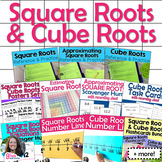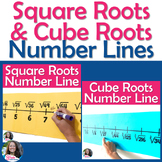Large Square Roots Number Line Poster for Approximating Square Roots
- PDF
What educators are saying
Also included in
- No more searching for everything to teach square roots and cube roots! This is all you need for teaching square roots and cube roots in 8th grade math! Save over 25% when you buy the bundle instead of buying each resource individually!This bundle includes:Square Roots & Cube Roots Poster SetSquaPrice $31.00Original Price $42.00Save $11.00
- Here is everything you need to start your school year in middle school math! Whether you are a new teacher or switching to grades 6-8 for the first time, this bundle has you covered with vocabulary posters, first day activities, classroom décor, and more! By purchasing this bundle, you save over 35%Price $120.00Original Price $184.75Save $64.75
- Get BOTH the Square Roots Number Line and the Cube Roots Number Line to display in your classroom! These can be hung in your algebra classroom all year or only used when teaching irrational numbers on a number line.Square Roots Number Line: This is ideal for beginning to teach approximating square rPrice $4.50Original Price $6.50Save $2.00
Description
This is ideal for beginning to teach approximating square roots! You can hang this number line in your classroom all year or just get it out as you start to estimate square roots of non-perfect square.
Simply print the 5 pages and tape them together to create a number line that goes from 1 to 15. NEW! Now, you can also include negative numbers. Print the additional 5 pages to include numbers -14 through 0.
There are 2 versions.
- 1 version with the integer equivalents
- 1 version with just the square roots of perfect squares
Check out the preview to see more.
You can laminate it and use dry-erase markers to plot points. Use this to help students use rational approximations of irrational numbers and locate them approximately on a number line.
This is math classroom décor with a purpose! I love hanging this above my board so students can reference all year... even before they even know what those radical symbols mean.
Get number line displays for both square roots and cube roots and save with this Square Roots & Cube Roots Number Lines Bundle.
Check out this poster for your virtual classroom! Square Roots Virtual Classroom Number Line
Please follow me -8th Grade Math Teacher
You may also like...
Approximating Square Roots Reference and Practice Worksheet
Estimating Square Roots Grid Mat
Square Roots of Perfect Squares Reference & Practice
Square Roots & Cube Roots Poster Set
Approximating Square Roots Scavenger Hunt
Comparing Irrational Numbers Tournament Worksheet
Multiplying in Scientific Notation Game








